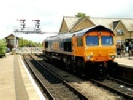Archive Section



3rd January 2012
Tim Roberts, Network Rail
The first speaker of the New Year was Tim Roberts, from Network Rail's Operations Centre. He started by giving a brief run through of his career. Following a family move to Wiltshire from Hull, Tim started as a signaller at Lavington, a box he knew well from unofficial schoolboy visits! A move to Bedwyn box followed, then a clerical job at Reading. In 1964 Tim was involved in the early days of the TOPS. The next job was the one that has evolved into the current one at the National Operations Centre (NOC), which moved to temporary offices at Milton Keynes Station in June 2011. The new permanent building is being built nearby.
The NOC is a "one stop shop", which has eight staff. Operation updates are sent out four times a day. They are punchy one-
The Route Controller can have other operators in the room, e.g. Birmingham Control also has Virgin and London Midland, Swindon has First Great Western, and Glasgow has Scotrail. This makes co-
The next part of Tim's talk, about modern technology, was spoiled by modern technology! Unfortunately a power point presentation just would not work, despite much effort! Part of this would have been a demonstration of box train recorders, in one instance a reported head on "near miss" could be investigated, and dismissed. A reliable reporter described his train swaying and a passing train almost making contact. Interviewing the relevant train company's staff, and track workers, the issue was unclear. But by reviewing the box tapes all was explained. Both trains were crossing from fast to slow lines, due to Sunday engineering work, and the reporter happened to be looking out of the window as the trains passed on the crossing!
A Bridge Strike Nominee (BSN) is now the first to report the status following a hit. There are categories, from Red (stop all trains) through to Green (ok to run line speed). This has proved to be a quicker, with safety in mind, way to get trains moving again.
Tim finished with a Questions & Answer session, which included questions on axle counters, stranded trains, the relationship between infrastructure and TOC operators, and an observation from the floor that the railways talk AT each other, not TO each other!
